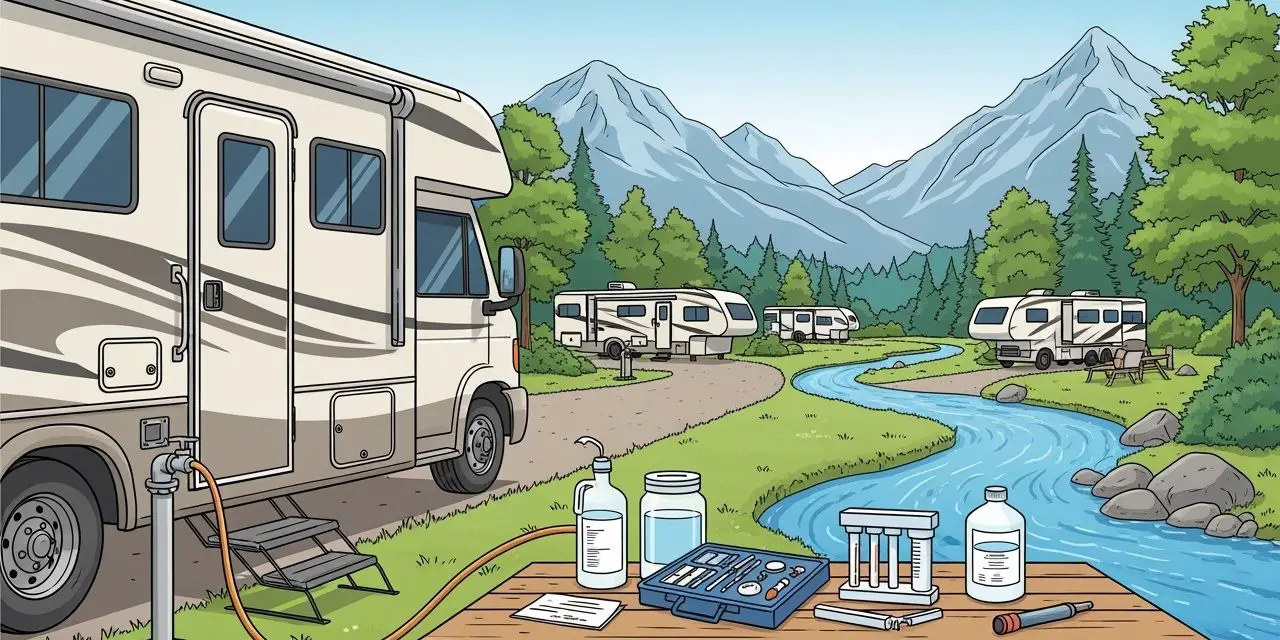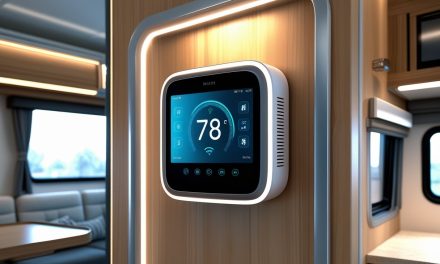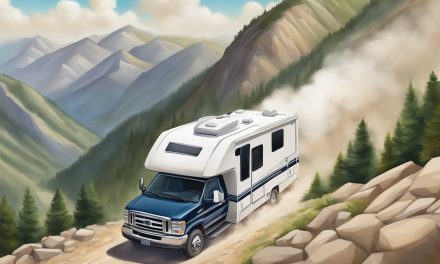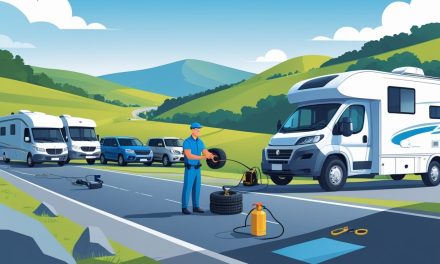Would you like to save this article?
You’ve been there before – you pull up to your favorite campsite, hook up your RV to that rusty water spigot, and wonder if you’re about to give your family water that’s been filtered through a gym sock and a burnt tire.
According to recent testing data, over 40% of campgrounds report chlorine taste issues, while 35% deal with sediment problems that can make your morning coffee taste like liquid concrete.
But here’s the kicker: most RVers have no idea what’s actually flowing through their taps until it’s too late. Whether you’re dealing with municipal water that smells like a swimming pool or well water that tastes like broken dinosaur eggs, understanding campground water safety isn’t just about comfort – it’s about protecting your family’s health on the road.
1. That “Potable Water” Sign Doesn’t Mean What You Think It Does
You see that weathered “Potable Water” sign next to the campground spigot and assume you’re good to go. But here’s what most RVers don’t realize: campground water testing requirements vary dramatically by state and local jurisdiction. While some campgrounds connected to municipal systems get monthly testing, others relying on private wells might only test quarterly – or less frequently if they’re not under regulatory oversight.
The EPA can actually shut down campgrounds that don’t properly test their water supplies, but enforcement is inconsistent. Many smaller campgrounds operate under the radar, especially those with private water systems serving fewer than 25 people. These systems often fall into regulatory gray areas where testing isn’t mandated unless there’s a specific complaint or health incident.
Supporting Facts:
- Campgrounds serving 25+ people daily are classified as public water systems requiring regular testing
- Private campground wells may only require annual testing for coliform bacteria and nitrates
- Brown water can still pass state water tests if it’s not “too murky” according to current standards
Real talk: Just because it says “potable” doesn’t mean it’s pleasant. I’ve seen campground water that technically met EPA standards but looked like chocolate milk. Would you serve that to your kids at home?
2. Municipal vs. Well Water: The Battle for Your Taste Buds
The source of your campground water makes a massive difference in what comes out of your faucet. Municipal water systems typically undergo rigorous chlorine treatment and monthly testing, but they can taste like you’re drinking from a swimming pool. Well water systems offer that “natural” taste that can range from pleasantly mineral-rich to smelling like sulfur-soaked pennies.
Here’s the breakdown: Municipal systems cost campgrounds less to maintain but offer less control over taste and odor. Well systems give campgrounds more control but require more expensive treatment equipment and monitoring. The catch? Well water campgrounds can have wildly inconsistent quality depending on seasonal changes, nearby agricultural runoff, and the age of their infrastructure.
Key Statistics:
- 60% of campgrounds use municipal water connections
- 35% rely on private well systems
- 5% use a combination of both sources
- Well water systems show 3x more variation in mineral content than municipal supplies
Here’s the thing: Municipal water might taste like pool water, but at least it’s consistently pool water. With well water, you’re playing Russian roulette with your morning coffee – it could be delicious or taste like wet pennies had a fight with rotten eggs.
3. The Most Common Water Problems Will Surprise You
You might think bacteria and lead are the biggest concerns, but sediment and taste issues top the list of campground water problems. Based on comprehensive testing data, chlorine taste affects 40% of campgrounds, while sediment issues plague 35% of facilities. Meanwhile, the scary stuff – bacteria (15%) and lead (8%) – ranks lower but poses much more serious health risks.
High pH levels (25%) can make your water taste bitter and cause your soap to stop working properly. Rust problems (20%) leave orange stains in your RV’s water system and can indicate aging infrastructure that might harbor other contaminants. The real issue isn’t just what you can taste – it’s what you can’t detect without proper testing.
Infrastructure Reality Check:
- Average campground water infrastructure is 15-20 years old
- 25% of campgrounds have pipes installed before 1990
- Seasonal campgrounds face freeze-thaw cycles that stress water systems
- Remote locations often have limited access to maintenance and repair services
Plot twist: The stuff that makes your water taste terrible (chlorine, minerals) is usually harmless, while the dangerous contaminants (bacteria, lead) are often completely undetectable without testing. It’s like nature’s cruel joke on RVers.
4. Your RV Water Filter Isn’t the Hero You Think It Is
Standard RV water filters are like bringing a butter knife to a gunfight – they’ll handle the basics but can’t tackle serious contamination. Most inline filters only address sediment and chlorine taste, removing particles down to 1 micron and reducing that swimming pool flavor. But bacteria, viruses, and dissolved chemicals? They’re mostly still along for the ride.
The dirty secret of RV water filtration is that most filters need replacement every 3-6 months, but the average RVer changes theirs maybe twice a year. A clogged filter can actually make water quality worse by becoming a breeding ground for bacteria. Carbon filters, the most common type, lose effectiveness gradually – so you might not notice your “protection” has been compromised for months.
Filter Effectiveness Reality:
- Standard carbon filters: 60-80% effective for chlorine removal
- Sediment filtration: 90-95% effective for particles larger than filter rating
- Bacteria removal: 10-30% effective (not designed for biological contaminants)
- Chemical removal: 40-70% effective depending on specific contaminants
Here’s the uncomfortable truth: Your $50 inline filter gives you a false sense of security. It’s great for making water taste better and removing chunks, but if there’s serious contamination, you’re still drinking it – it just tastes better going down.
5. The Simple Test That Changes Everything
The game-changing revelation from comprehensive campground water testing is how simple it is to know what you’re actually drinking. Professional water testing kits that check for 14 different contaminants cost under $30 and can be done right at your campsite. The coliform bacteria test (checking for fecal contamination) takes 72 hours but uses a simple color-change system. The lead test? Five minutes and four drops of water.
Most RVers spend more on a dinner out than they would on a testing kit that could reveal serious health hazards. The bacteria test alone can detect contamination that affects 15% of campgrounds, while the lead test identifies problems that standard filters can’t address. Testing revealed that water meeting EPA standards can still have issues that affect taste, appliance longevity, and long-term health.
Testing Timeline:
- pH test: 2 minutes (instant color change)
- Chlorine levels: 2 minutes (instant color change)
- Lead contamination: 5 minutes (color development)
- Bacteria presence: 72 hours (observation period)
- Heavy metals: 5-10 minutes (multiple test strips)
Mind-blowing reality: We’ll spend $500 on a fancy water filter system but won’t drop $25 on a test kit to find out if we actually need it. It’s like buying earthquake insurance without checking if you live on a fault line.
The Bottom Line: Knowledge is Power (and Better Coffee)
| Water Source | Pros | Cons | Best For |
|---|---|---|---|
| Municipal | Consistent quality, regulated testing, widely available | Chlorine taste, chemical treatment, less control | RVers prioritizing safety over taste |
| Well Water | Natural taste, mineral content, no chemicals | Variable quality, sulfur smell, seasonal changes | Experienced RVers with good filtration systems |
| Filtered | Improved taste, sediment removal, peace of mind | False security, maintenance required, limited protection | All RVers as a baseline protection |
You’re not just a camper – you’re a water quality detective on wheels. The difference between a great camping trip and a disaster often comes down to what’s flowing through your water line. With 40% of campgrounds reporting taste issues and 35% dealing with sediment problems, your standard approach of “hook up and hope” isn’t cutting it anymore.
The solution isn’t avoiding campground water – it’s understanding what you’re working with. Test first, filter appropriately, and know when to switch to bottled water. Your morning coffee (and your family’s health) will thank you.
SOURCES
- RV Life – Is Campground Drinking Water Contaminated? – Comprehensive analysis of campground water contamination risks and testing requirements
- CRR Hospitality – Maintaining Water Quality in Campgrounds: A Regulatory Overview – Detailed breakdown of water quality regulations and testing requirements for campgrounds
- EPA Water Quality Standards – Official EPA guidelines for water quality standards and regulations
- Trek With Us – The Complete Guide to RV Water Filtration – Analysis of RV water filter effectiveness and limitations
- FindLaw – EPA Can Shut Down Campground for Not Testing Water – Legal precedent for campground water testing enforcement
- NEIWPCC – Safe Drinking Water And Your Campground – Comprehensive guide to campground water safety management






